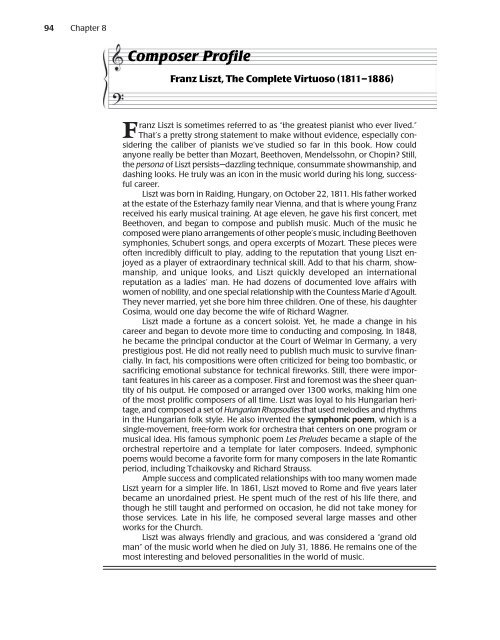Composer Profile - Activefolio
Composer Profile - Activefolio
Composer Profile - Activefolio
Create successful ePaper yourself
Turn your PDF publications into a flip-book with our unique Google optimized e-Paper software.
94 Chapter 8<br />
<strong>Composer</strong> <strong>Profile</strong><br />
Franz Liszt, The Complete Virtuoso (1811–1886)<br />
F ranz Liszt is sometimes referred to as “the greatest pianist who ever lived.”<br />
That’s a pretty strong statement to make without evidence, especially considering<br />
the caliber of pianists we’ve studied so far in this book. How could<br />
anyone really be better than Mozart, Beethoven, Mendelssohn, or Chopin? Still,<br />
the persona of Liszt persists—dazzling technique, consummate showmanship, and<br />
dashing looks. He truly was an icon in the music world during his long, successful<br />
career.<br />
Liszt was born in Raiding, Hungary, on October 22, 1811. His father worked<br />
at the estate of the Esterhazy family near Vienna, and that is where young Franz<br />
received his early musical training. At age eleven, he gave his first concert, met<br />
Beethoven, and began to compose and publish music. Much of the music he<br />
composed were piano arrangements of other people’s music, including Beethoven<br />
symphonies, Schubert songs, and opera excerpts of Mozart. These pieces were<br />
often incredibly difficult to play, adding to the reputation that young Liszt enjoyed<br />
as a player of extraordinary technical skill. Add to that his charm, showmanship,<br />
and unique looks, and Liszt quickly developed an international<br />
reputation as a ladies’ man. He had dozens of documented love affairs with<br />
women of nobility, and one special relationship with the Countess Marie d’Agoult.<br />
They never married, yet she bore him three children. One of these, his daughter<br />
Cosima, would one day become the wife of Richard Wagner.<br />
Liszt made a fortune as a concert soloist. Yet, he made a change in his<br />
career and began to devote more time to conducting and composing. In 1848,<br />
he became the principal conductor at the Court of Weimar in Germany, a very<br />
prestigious post. He did not really need to publish much music to survive financially.<br />
In fact, his compositions were often criticized for being too bombastic, or<br />
sacrificing emotional substance for technical fireworks. Still, there were important<br />
features in his career as a composer. First and foremost was the sheer quantity<br />
of his output. He composed or arranged over 1300 works, making him one<br />
of the most prolific composers of all time. Liszt was loyal to his Hungarian heritage,<br />
and composed a set of Hungarian Rhapsodies that used melodies and rhythms<br />
in the Hungarian folk style. He also invented the symphonic poem, which is a<br />
single-movement, free-form work for orchestra that centers on one program or<br />
musical idea. His famous symphonic poem Les Preludes became a staple of the<br />
orchestral repertoire and a template for later composers. Indeed, symphonic<br />
poems would become a favorite form for many composers in the late Romantic<br />
period, including Tchaikovsky and Richard Strauss.<br />
Ample success and complicated relationships with too many women made<br />
Liszt yearn for a simpler life. In 1861, Liszt moved to Rome and five years later<br />
became an unordained priest. He spent much of the rest of his life there, and<br />
though he still taught and performed on occasion, he did not take money for<br />
those services. Late in his life, he composed several large masses and other<br />
works for the Church.<br />
Liszt was always friendly and gracious, and was considered a “grand old<br />
man” of the music world when he died on July 31, 1886. He remains one of the<br />
most interesting and beloved personalities in the world of music.



